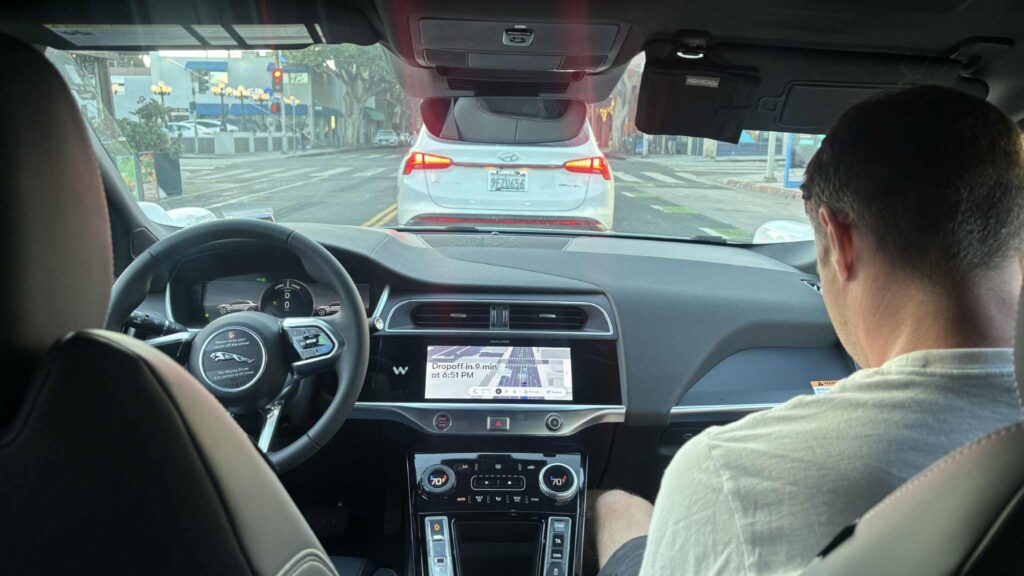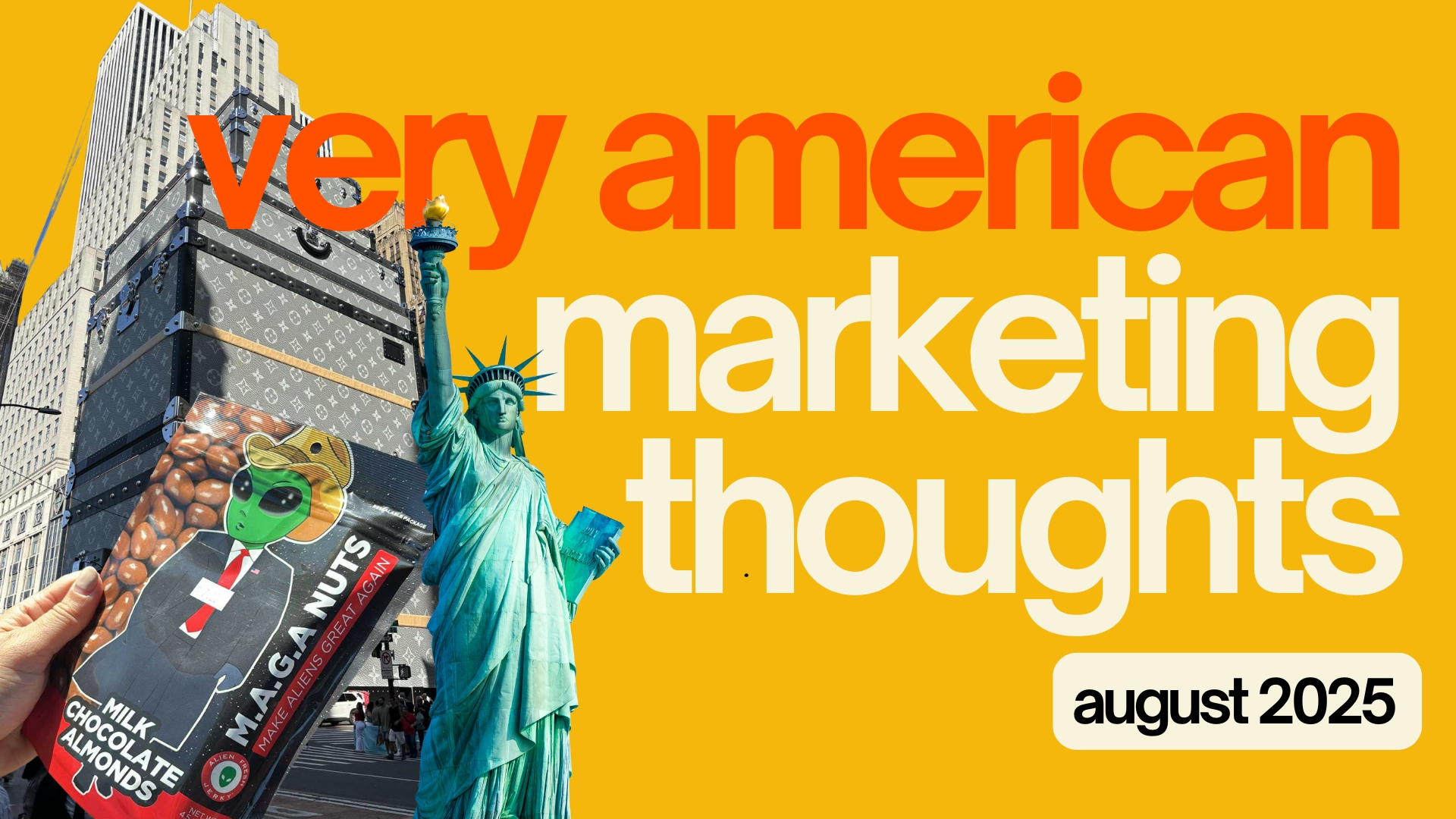I just got back from 4 weeks in the U.S. and, wow, do I have some THOUGHTTTTTS. I honestly thought I’d be writing about politics and trump and all that jazz (because Australian media makes you feel like you’re walking into The Purge) but honestly? It was so fine. People told us not to go. We went. We had a great time. Media hype is a *hell* of a drug.
Anyway – without further ado, the marketing/brand/experience edition of my trip!
robots, but make it customer service
In LA, we kept spotting Waymo driverless cars and finally gave one a go. Creepy AF at first (no driver, no chatter, no awkward “so how’s your night been?”), but once we settled in… it was honestly the best drive of the trip. Stress-free, music on, aircon perfect, and when traffic held us up? The app auto-refunded $10 without me even asking.
The day before, we’d had an Uber with a driver on the phone the whole ride. Fine, but not great. And it got me thinking about this whole debate on robots replacing us… I don’t think robots can replace good human experiences. But if the human side is distracted, half-assed, or just “fine”? Then yeah, the robot wins… every time.
I feel like we all panic so much about tech “stealing jobs,” but really it’s only threatening the ones that stopped being truly human in the first place. When you strip service back to a transaction, of course an algorithm can do it better and cheaper. But the warmth, the care, the moments that make you feel looked after? No machine can replicate that.
So maybe the point isn’t to fear the robot. It’s to make sure your customer experience is THAT good, no one wants an alternative.
(PS – still one of the weirdest things I’ve ever done. My brain never quite adjusted to the empty driver’s seat.)

uber for oldies = ux win
Travelling with my in-laws across the U.S. really made me notice how invisible tech has become for those of us who live in it. Tap cards for subways, QR-code menus, hotel check-ins through apps – it’s all second nature to me / anyone who uses tech. But for them? It’s overwhelming. You suddenly see how many tiny assumptions are baked into modern life, and how much we just expect people to “figure it out.”
So while trying to update my card in the Uber app thanks to Westpac making our lives 10x harder (that’s a rant for another day) – I saw in the settings something I hadn’t seen before – a “Simple Mode”. It basically strips the app down to larger text and fewer buttons. (and family members can manage rides and payments too). I turned it on out of curiosity, and it was SO GOOD. Clean, uncluttered, easy to use. A totally different experience than the usual uber app (it even took away the ads!).
And seeing just how overwhelmed my in-laws were getting made me think… why don’t more platforms do this? Why is “making things simple” seen as less sophisticated, when in reality it can be the most powerful form of design? Imagine if Meta had a senior mode – my Pop could finally scroll through family photos without accidentally commenting on posts from strangers. That’s not a downgrade in UX; that’s expanding access.
It’s such a good reminder that the best products aren’t built for just the most tech-enabled among us. True UX brilliance is making something feel achievable, no matter who’s holding the phone (or trying to order themselves a beer in a bar!).

hi i’m roy, i’m 21
Times Square has no shortage of billboards screaming at you with colour, celebrity faces, and production budgets bigger than some small countries. Which is why this one stopped me and got me to read it: white background, plain text:

And of course I went to the site. Of course I screenshotted it. And of course I sent it to a friend. Because even though I’ve seen this “raw, zero-design” aesthetic before – Koala did it brilliantly for years and ripped-cardboard-style ads were everywhere in 2023/24 – this felt different. It felt human. I believed there was a real 21-year-old behind it who had spent every dollar they had on one chance to get noticed.
That’s the difference. When something feels genuine, it works, even if the style has been overdone. The same billboard executed by a major brand, with a wink and a nudge? Probably wouldn’t hit. But Roy? Roy made me care. Whoever you are Roy, well done. 11/10. No notes.
As much as brands chase polish, design trends, and celebrity alignments, people still want to buy from other people. Sometimes the best creative is just saying: “Hey, it’s me. I’m here. I need this to work.”
tipping, taxes & torture
Coming home to Australia and seeing “the price = the price” honestly felt EUPHORICCCCC (not even being drastic here). In the US, every meal was a maths exam. A burger listed at $20 quickly became $30+ once you added a mandatory 20% tip, 10% tax, and – in some cases – an extra “cost of living fee.” (literally a made up 10% tax they just decided to add lol).
And I while that was annoying, it wasn’t the total at the end of the receipt that got me frustrated – it was the process. Paying meant flagging down a server, getting the little folder, putting your card in, waiting for them to pre-auth, getting it back, writing in your tip by hand, signing, calling them again, and finally being handed three different receipts. It could take fifteen minutes just to leave a restaurant.
And here’s what I don’t get: if tipping is now essentially mandatory (and often auto-applied), why not just fold it into the price and make the whole thing seamless? I’m not saying don’t tip – I get that people rely on it – but the experience is stuck in the past. This is a country leading the world in innovation, yet the act of paying for lunch feels like 1995.
It made me realise how much “customer experience” extends to the boring stuff (and how much of my marketing thoughts in the US all came back to CX). The checkout. The bill. The admin. You can serve the best meal in the world, but if the end of the night leaves your customers frustrated, they’ll remember that more than the food.
pep, passion & pumpkins
We went to a USC college football game. SEVENTY THOUSAND people (mind blown). Fireworks. Cheerleaders. A full marching band blasting in sync with the crowd. People decked out head-to-toe in merch. And everyone was all in (to say the least). And it was college, not NFL… college.
It reminded me of my exchange days in North Carolina, but it also reminded me how different the vibe is back home. In Australia, we’ve got this tall poppy thing where it’s not “cool” to get too excited. We roll our eyes at people who are “too into” something. We downplay our passions, and sometimes even tease others for leaning in too hard.
But in the US, they embrace it. Halloween houses fully decorated weeks in advance. Pumpkin spice everything. Entire neighbourhoods shifting their front porches to match the season. It’s not subtle, but it’s infectious. Passion feels bigger there, and people feed off it. (And am fully aware that not everything they’re passionate about is a good thing… a few things come to mind lol)
But it for sure had me thinking: what if we stopped being so afraid of caring too much? What if we leaned in, even when it feels uncool? Because honestly, excitement is magnetic. Whether it’s a sport, a holiday, or even a hobby, passion creates energy. And brands could use more of that too. I don’t even know if this is a marketing thought or a life thought – but definitely something I’m thinking about!

the power of novelty
Novelty is alive and well in America. In New Orleans we found a bar serving cocktails in blood bags (if you haven’t watched Vampire Diaries/The Originals – don’t talk to me). Near Area 51 we bought “Alien Jerky” that tasted exactly like servo jerky, plus chocolate almonds that were triple the price and half the flavour. But still… WORTH IT.

And that’s the thing – novelty beats quality when it comes to experience. A regular cocktail is $10. The same cocktail in a blood bag? $22, and people (me) happily line up for it. It’s not about taste or value – it’s about the story, the Instagram post, the “you have to try this” moment.
In crowded markets, being the “best” often isn’t enough anymore. People will travel for something unique, even if it’s average once they get there. They’ll tell their friends about it, post it online, and add it to their list for next time. That halo of “this place is special” is often stronger than “this place is technically better.”
Novelty doesn’t have to be gimmicky – but it does have to be different. And if you can deliver something no one else is doing, people will forgive you for being good-not-great. Because no one’s telling their mates about the standard $10 cocktail. But they will tell them about the one that came in an IV bag.
big still works
For all the talk about AI, tech stacks, and digital disruption, I was surprised by how much “just make it maaaaassive” still works. The Louis Vuitton store in New York styled to look like a giant pile of luggage. Planes dragging banners across Venice Beach. Oversized cowboy statues on dive bars. These things stop people in their tracks.

There’s something so interesting about scale. You can’t scroll past it. You can’t ignore it. Even in a city like New York, where stimulation is everywhere, people still pause when something is too big to miss.
It feels almost stupidly simple, but maybe that’s why it works. In marketing we get obsessed with nuance and complexity. We want clever tech, complex targeting, the next platform trick. But sometimes the answer is just: make it huuuuuuuge. Blow it up until people can’t look away.
It’s not always the right play, but it’s funny how often “big” still beats “smart.” And in 2025, when everyone’s chasing the new shiny thing, maybe going back to the basics is the real disruption (yep, I used the word disruption sorry)
But for now – I’m back on Aussie soil, where the prices are the prices, the vibes are a little more low-key, and the cars still have drivers. For now.
